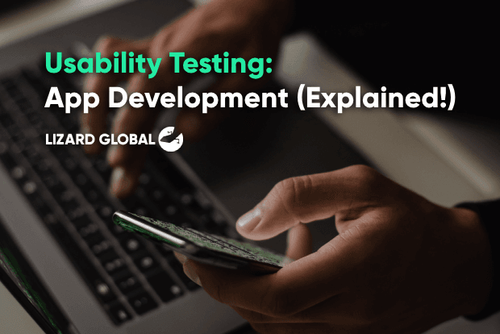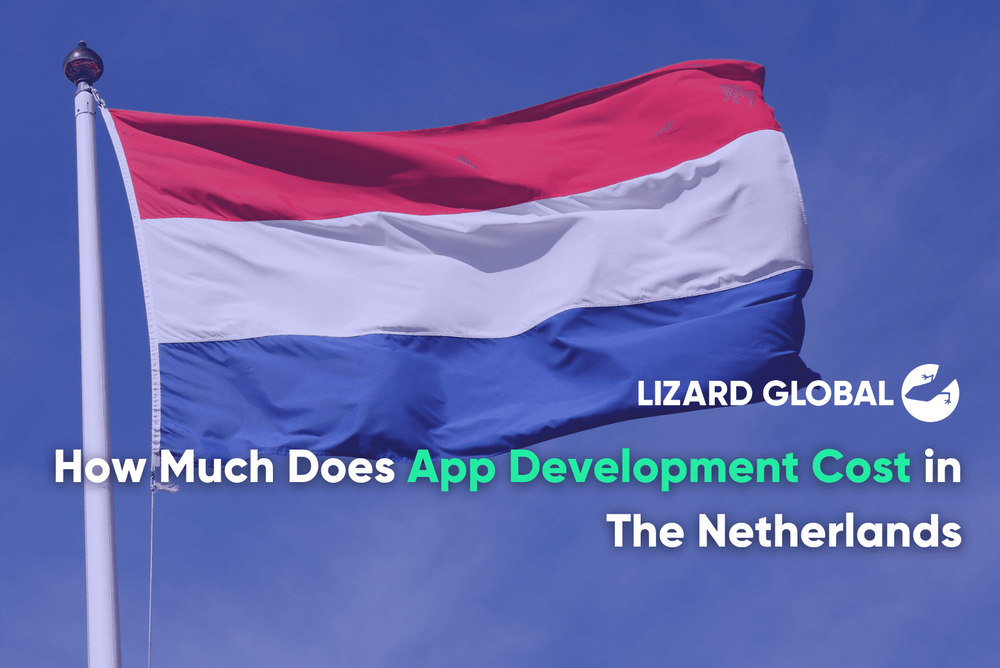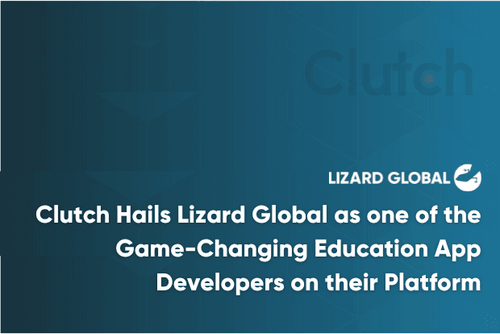Will AI Ever Rule the World? - The Next Big Thing in UI/UX
Get the latest updates about our blog posts.
Subscribe so you don’t miss out!
Follow Lizard Global on Facebook, Instagram, and LinkedIn.
Artificial intelligence, or AI, has significantly evolved in recent years, much like every other aspect of technology. We recently explored the game-changing capabilities of ChatGPT in app development, and now, businesses and brands are recognizing the industry-changing influence of machine learning. Business leaders have started embracing various forms of AI due to its ability to simplify complex operations and streamline workloads. Business leaders are moving towards technology that will modernize their organizations, and executives worldwide have already claimed that AI solutions have increased their companies' efficiency.
Although it is commonly thought that human touch will soon become fully unnecessary, this assumption isn't entirely correct given how the AI landscape will only be capable of streamlining commercial operations, but little to no human judgment. As a leading global mobile and web app development company with UI/UX design authority, our view is that there are many AI advances that still require industry strategists, designers, and developers to apply their best practices to these tools.
So, in this blog, we’ll go through how AI can benefit UI/UX, how to use machine learning in designing user interfaces, and answering the most sought-after question — can AI replace UI UX designers? Let’s go!
What is AI in UI/UX design?
Artificial intelligence (AI) lays out computer programs and other devices that may mimic intelligent human conduct. Because they have access to a lot of training data, these algorithms can make predictions by identifying patterns in the data. They are capable of perception, learning, prediction, and data analysis.
According to the human traits it can mimic, AI today falls into the narrow category where a learning algorithm is created to carry out a single, specialized activity without the aid of humans. Any information gained from completing that activity won't automatically transfer to others. It has yet to achieve its super AI level, where machines can display their own emotions, beliefs, and desires in addition to comprehending human feelings and experiences to exceed humans in any task.
Although this is true, artificial intelligence has ingrained itself deeply into our daily lives. Almost all industries are utilizing AI in some capacity, for instance, automating procedures, cutting expenses, and boosting efficiency. The sector of digital transformation is not an exception. How has AI revolutionized UX? We'll talk specifically about what AI has introduced and how it has affected UX design below. First of all...
What is the use of AI in user interface design?
Our previous blog has explored the impact of a good app design for your business, but studies predict that by 2025, the market for AI software would have grown 10 times. Contrary to popular belief, artificial intelligence UX design principles are different.
Designers build a user interface (UI) for the user. One of the jobs of the UX expert is usually closer to the end of the problem-solving process; that is, to determine the best approaches for testing designs with users, and with AI, all these processes can support more targeted designs and their methodology.
Wireframing and visual design
Many professionals know that UI/UX interplays when it comes to effective software design. Hence, UX designers play the director's job in evaluating items, providing research, and working on general tasks such as executing activities in visual design. They must finalize their design approach, take charge of the project, and conduct stakeholder meetings.
AI assists in analyzing changes independently and provides UI/UX designers with multiple variants or layouts (iterations). AI is advancing to save designers a lot of time by turning down the need for them to check and approve designs frequently. Machine learning gathers data, analyzes, and learns from data such as cursor movement, sketches, and more.
Design system
Designers with the user in mind intend a user interface (UI). Though the AI of today is capable of aiding user testing of designs, it is ultimately upon the shoulders of the UX specialist to engage users accurately. AI only takes over the task of UI graphic design, not the whole UI/UX design process.
Most businesses today employ designers and developers who respect this technology. Because they include visuals and instructions for various elements of the application, from a simple sketch, AI machines can design hypothetically effective systems.
Better design interfaces and/or experiences
Most UX professionals aspire to make their websites, mobile applications, or other digital product designs feel distinctive. As AI is becoming more involved in all aspects of our daily lives, every interaction we have with devices and machines around us is valuable data, making product designers more creative in framing the best-tailored visual experiences.
Generative AI, such as DALL-E, becomes a great help to designers in realizing personalized visions as they open the potential of creating custom imagery, graphics, backgrounds, and other creative materials such as icons with much lesser effort.

Is there an AI for UI design?
These AI-enabled solutions for UI/UX can greatly increase the efficiency of every design stage phase, including the design of layouts and templates. The UI/UX designers in Lizard Global have been embracing this technology.
Let's have a look at some of the top AI design tools available today and how you can use them in your job as a UI/UX designer.
Image upscaler
Modern AI and Super-Resolution technology have sped up the upscaling process with ImgUpscaler. Users can upscale and enhance photographs with little to no waiting. Your privacy is very well protected, and all images will be deleted within 24 hours.
Every week, ImgUpsclaler offers 5 free credits, however, their unrestricted access gives you access to an unlimited number.
Lorem ipsum
Lorem ipsum uses quantum AI machine learning algorithms to quickly produce your lorem ipsum text. In just three simple actions, you can enter how many characters you want to be generated, submit to have the lorem ipsum text auto-generated, and then copy and paste as needed!
Image background remover
Removal.ai instantly create a transparent background for your photographs to transform them into works of art, gorgeous banners, visual presentations, product catalogs, and graphics based entirely on your requirements.
You’ll get photos with a transparent, white, or custom background in 3 seconds or less for free. The AI automatically recognizes subjects in pictures to produce clean, distinct, and smooth cutout edges, and even capable of handling any fur edges, including hair! What’s even better, you’re open to processing more than 1,000 photos in a single upload.
ChatGPT
A user persona is a model of an ideal user. Personas are a tool that product designers use to assess their choices.
By using ChatGPT, product designers have created a shortcut for generating user personas. It gave pertinent contextual information as well as demographics, requirements, and wants for each character created using a variety of customized prompts from the creators themselves. Without spending too much time actively conducting general research, it enables designers to better understand how to make user-centric products or apps.

What are the benefits of AI in UX?
It was far quicker to create a mockup from a drawing than it was to do it using a UI design tool, like Figma. Even though it was evident that it needed to be fixed up and a few extra details added that the AI missed, the time saved with detailed sketching was amazing.
But to what extent can artificial intelligence be helpful if this is incorporated into the standard Product Design process?
Increasing user engagement
Every day, businesses rate and promote content using data and algorithms. With AI, UX design can make intelligent use of this data by analyzing the user behavior within a web app or mobile application to create a seamless user flow and prevent misleading users. Ultimately, thanks to this effect, Product Designers can make data-driven optimization to the engagement metrics.
Improving reliability
There is some ambiguity in AI, most notably in machine learning. That's because algorithms mine sample behaviors for trends. In this instance, making use of shortcomings and constraints is the best way to enhance the UX and create a seamless product design. Hence, it is crucial to take this into account when designing user experiences to prevent users from being misled.
Making data-driven decision-making
Sure, decision-making is a lot less stretching with the help of artificial intelligence. However, there sometimes is a catch. Not all user information may be accessible to an app or digital service. Consider a mobile app that stores numerous accounts with various data, it is unable to offer precise information or knowledgeable recommendations in this situation. By figuring out how to include user feedback, represent the veracity of the data, and enable users to make informed decisions, UX design plays a substantial role.

Will artificial intelligence affect UX designers?
Artificial intelligence (AI) enables UX designers to automate tedious processes like categorizing user actions, forecasting future behaviors, and extracting pertinent insights from massive amounts of user data—leaving extra time for perfecting the result.
Even though AI has the potential to be a potent tool in a UX designer's toolbox, it will never be able to replace human empathy fully. Developing a thorough grasp of human requirements and producing useful, appealing products that capture everyday user experiences will always be at the heart of UI/UX design. Leading workshops and working with stakeholders from across the business are important aspects of UX design and AI won't likely ever replace them.
And this brings us to the final question…
Can AI ultimately replace UI/UX designers?
Some elements of the user experience can be automated and enhanced using artificial intelligence. But for UX to be amazing, users' wants must be understood and rendered into a product. However, it won't likely take the position of human designers, the reality is. The function of UX designers may, however, evolve. There was a period when product development was handled entirely by developers. As product processes expanded, UX and UI designers established new industries. Naturally, as this position develops, more specialized user experience designers will be needed.
Need a hand?
Every single one of your users is unique, and we at Lizard Global are aware of this. They all interact with your web or mobile application differently since they each have different needs and interests. Given that, making an app that satisfies every user would seem to be impossible.
Years of experience have shown us, however, that you can significantly enhance the overall user experience of your app and thus increase user engagement if you get to know your audience segments better.
Want to know how to put yourself in their shoes from a business point of view? Contact us now!





